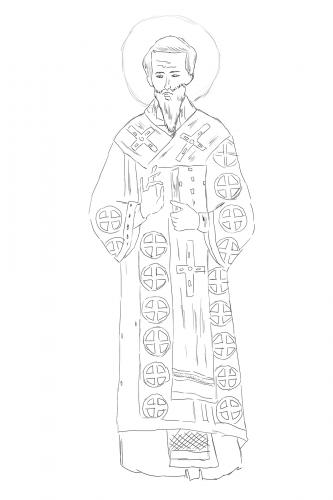



Saint Haralambos
The hagiographic legend identifies St. Haralambos as one of the first bishops of Magnesia (in Greece).During the reign of Septimius Sever – 2nd-3rd. century – the persecutions against Christians, as part of the imperial policy, became more numerous and severe. St. Haralambos, who had converted many believers, was arrested, judged and, professing his faith by refusing to sacrifice to the Olympian gods, tortured by flaying alive and mutilation with iron nails. His strong faith and the miracles performed convinced many to convert, among whom the pro-consul who had ordered his tortures. Arrested again, St. Haralambos is tortured in Antiochia, being flayed alive in the emperor’s presence. Miraculously healed, the Saint is asked to heal a person possessed by devil and to bring back to life a dead child and he performed both by prayer. The even greater number of converts, the emperor’s daughter included, brought him the capital punishment by decapitation.
St. Haralmbos’ relics are to be found in Romanian churches and monasteries, especially in Bucharest, where he is considered a protector against the plague.
Iconographically, St. Haralambos may be shown as St. Bartholomew, exposing his flayed skin, but more frequently he is represented as a priest, or, under the influence of the Russian school, as a bishop. Usually he is depicted full length or half length, clad in liturgical vestments: sticharion, epitrachelion and phelonion. In his left hand, close to his chest, he is holding a closed Gospel, while he is blessing with the right hand. As far as the facial traits are concerned there I no special canonical recommendation. However, common to most of the representations are the whiteness of the hair and long beard as well as the emaciated face of the saint. It is worth noticing that St. Haralambos does not wear the martyr’s attributes: the crown or palm branch.
The hagiographic legend identifies St. Haralambos as one of the first bishops of Magnesia (in Greece).During the reign of Septimius Sever – 2nd-3rd. century – the persecutions against Christians, as part of the imperial policy, became more numerous and severe. St. Haralambos, who had converted many believers, was arrested, judged and, professing his faith by refusing to sacrifice to the Olympian gods, tortured by flaying alive and mutilation with iron nails. His strong faith and the miracles performed convinced many to convert, among whom the pro-consul who had ordered his tortures. Arrested again, St. Haralambos is tortured in Antiochia, being flayed alive in the emperor’s presence. Miraculously healed, the Saint is asked to heal a person possessed by devil and to bring back to life a dead child and he performed both by prayer. The even greater number of converts, the emperor’s daughter included, brought him the capital punishment by decapitation.
St. Haralmbos’ relics are to be found in Romanian churches and monasteries, especially in Bucharest, where he is considered a protector against the plague.
Iconographically, St. Haralambos may be shown as St. Bartholomew, exposing his flayed skin, but more frequently he is represented as a priest, or, under the influence of the Russian school, as a bishop. Usually he is depicted full length or half length, clad in liturgical vestments: sticharion, epitrachelion and phelonion. In his left hand, close to his chest, he is holding a closed Gospel, while he is blessing with the right hand. As far as the facial traits are concerned there I no special canonical recommendation. However, common to most of the representations are the whiteness of the hair and long beard as well as the emaciated face of the saint. It is worth noticing that St. Haralambos does not wear the martyr’s attributes: the crown or palm branch.




